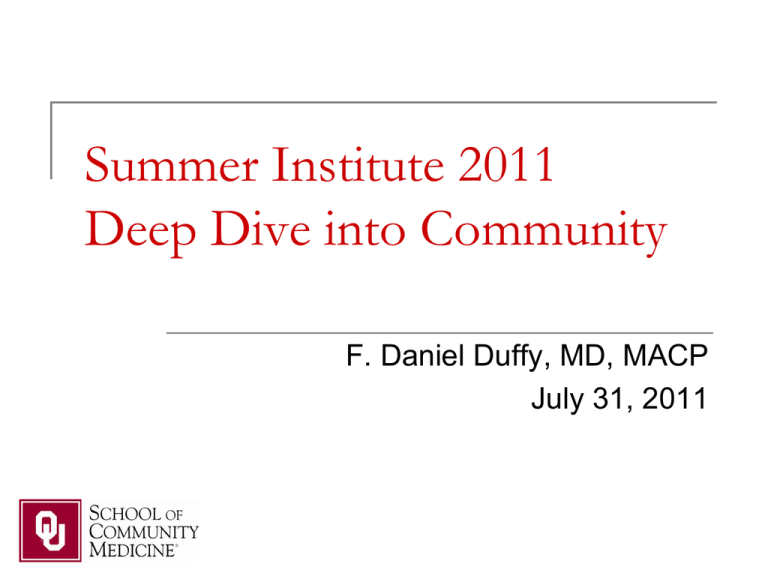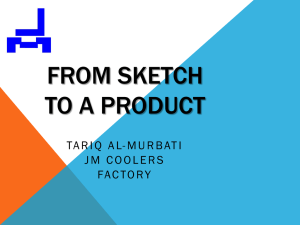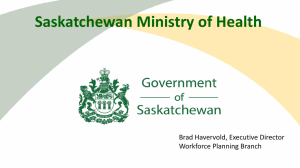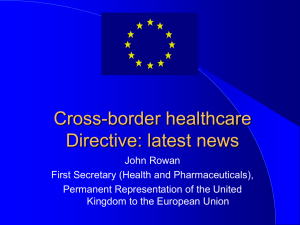Why Community Medicine
advertisement

Summer Institute 2011 Deep Dive into Community F. Daniel Duffy, MD, MACP July 31, 2011 Why Community Medicine Present Why are we here? Present Future Access for all Coordinated care Complete information Good communication Highest quality Affordable costs Altruism in care How might we do it? School of Community Medicine Present Future Access for all Coordinated care Complete information Good communication Highest quality Affordable costs Altruism in care How do we build it? School of Community Medicine Present Future Plan & design Access for all Coordinated care Complete information Good communication Highest quality Affordable costs Altruism in service Community Medicine is a Movement Moves from isolated and self-interested silos to connectedness and care for the whole Shifts from problems to be solved to our community’s positive potential Encourages collaboration in creating the future that cares for the whole Theory U The way in which we attend to a situation determines how a situation unfolds: I see it this way, therefore it emerges that way. Principles and practices for collectively creating the future that needs us to emerge. Otto Sharmer, 2009 How does the “U” Journey Work? Present Future LISTEN EVOLVE to others and to what life calls us to do ecosystems by acting from the emerging whole SENSE Go to the places of most potential, observe and listen with our minds, hearts and wills wide open CREATE Prototype a microcosm of the new to explore the future by doing PRESENCE Retreat and reflect to allow inner knowing to emerge Co-Sensing: Listen, Discover, Connect Anchoring Lectures Dialogue Groups Appreciative Inquiry Windshield Survey Poverty Simulation Shadowing Patients World Café Learning from the past Go out and see the community Dialogue, listen deeply, connect with mind, heart, and will wide open Observe, observe, observe; suspend voice of judgment, cynicism, fear Harvest the themes of the whole system Appreciative Inquiry Interviews We use Dialogue to focus on the individual’s or group's most positive potential – not on their problems! We inquire in order to appreciate another’s experience with an open mind, open heart and open will. Our conversations appreciate rather than criticize and judge Patient Dialogue Challenges you face with your health Works well to help you Someone we should recognize for helping you? Other people or things that have helped you Just one thing that would make the healthcare you receive better Windshield Survey Provider Dialogue Describe team’s observations from patient How you and your practice team help patients cope What works well Someone we should recognize for their help Challenges you face Community agencies or services enlisted to help Just one thing that might improve healthcare Social, Healthcare, & Public Services Describe team’s observations about challenges and successes How you or your agency help patients and providers What works well Someone we should recognize for good work Challenges you face One thing you would change to improve your service Experiencing Others’ Lives Poverty Simulation Shadowing Patients World Café Hospitable Café-like setting Answer meaningful questions about healthcare ecosystem Everyone contributes Hosts Travelers Cross pollination Diverse perspectives Create a summary Harvest themes about the whole system Patient, Provider, Social, Healthcare & Public Service Agency Observations Team Health Challenges Services Provided Works Well Recognize Challenges Just One Thing Themes about the Whole System INTERVIEW Patient Provider Social Services Healthcare Services Public Services Unifying Theme MAJOR THEME Co-Presencing Professional Calling What are we collectively sensing about the professionals we being called to become? What service that is larger than ourselves are we being called upon to freely give ourselves to? How have we been moved by our travel into our community and our dialogue with patients, providers, social, healthcare, and public services? Reflection on Professional Calling for our Lives Wednesday Noon Start UP the U Observe prototypes of community-based participatory action research World Café What did you learn from the research? What do agencies need from us in healthcare ecosystem? Co-Creating: Prototype 0.8 Quickly build an experiential microcosm of the future that needs you to come into being Present work in progress before being fully developed Get feedback to improve it and make it more useful Explore the future by doing rather than thinking about it Create prototype 0.8 microcosms How will we build Prototypes 0.8? Marketplace of ideas Group builds prototype Self selected groups attracted to an idea Develop a prototype microcosm of the future that prevents the problems of the present Stakeholder feedback Select prototypes with greatest potential Prototype 0.8 Solution Poster Issue: Patient repeats history multiple times Title: Patient INFO to Team: JB.CD. EMR Quickly RK. SW. FG HO Future Condition Patient generated form Background/Measures • Patient survey 50% poor history • Nurse/doctor delays, patient waits Current Condition Repeated questions Root Cause Analysis Why? – Tradition Why? – Training students Why? – Habit of practice Why? – Forms in EMR Why? – No time to develop Countermeasures: Patient Questionnaire Implementation Plan: Task Who When Outcome Forms J.B. EMR C.D. Training RK 8/1 8/15 8/30 New form Template “can do” Cost Benefit Save time $600 Rapid Cycle Test of Change IM Clinic Team 1, SW, 9/1-10 Follow-up – Expected Measure Patient wait time drops 50% Prototype Feedback Rating Form CATEGORY QUESTION Rate 1 (lowest) to 10 (highest) Issue Is the issue statement clear? Background/Measures Do background data or measures describe issue? Current Condition How easily can you grasp the current condition? Root Cause Analysis Has analysis identified the root cause of the issue? Title and Bylines Is the Prototype titled, with authors &date created? Future Condition How quickly can you grasp the future condition? Implementation Plan Are tasks for “bringing to market” specified? Cost Benefit Analysis How realistic is the cost & benefit analysis? Follow-UP How effective is prototype as a microcosm of a future health care system? Overall Design How well designed & user friendly is the prototype? Prototype Poster Prototype Poster Presentation Co-Evolving: Act as Part of Ecosystem Systems governed by: Markets Hierarchy (regulation) Networking Added governing force: Seeing from “presencing” the emerging whole Acting from our crystallized vision of the future Grow innovation ecosystems by seeing and acting from the emerging whole What Have We Learned from Summer Institutes? 2008 OU-Tulsa committed to improving health & healthcare Government leaders need our help in making wise policy Everyone can become vulnerable and need help from others OU-Tulsa can focus its discovery on the health of community The helping professions have a moral imperative to service 2009 Dr. Clancy told of taking psych care from hospital to street The structure of community profoundly influences its health Social determinants of health change our genes Personal health habits cause disease and can be changed Market driven healthcare conflicts with ethics & social justice We can crystallize a vision for a future healthcare ecosystem 2010 Concepts from Anchoring Lectures Early childhood education & trauma impact adult health Research is both innovation & system improvement Change in laws may change the healthcare ecosystem Successful collaboration yields healthcare results Lessons from Community Dialogues Tulsa’s history full of violence and community separation Social agencies eager to help – but disconnected from primary care Poverty is not a choice, can happen suddenly, is a hard lifestyle Health care institutions seem to be isolated from community needs Uninsured patients appreciate access to affordable care Collaboration changes health and healthcare We find it hard to appreciatively listen to each other Photovoice gives the silent members of our community a voice Moving from idea to prototype to system change is very hard work Interdisciplinary education, care, and research Healthcare Policy – Medicaid Sooner HAN, Diabetes Bridge Clinic – coordination of care Patient Centered Medical Home – pay for coordination Community-wide Health Information Exchange – MyHealth Prototype 0.8 2008 Take it to the streets – Put a Bedlam clinic at KIIPP Academy and use Community Advocate to build trust Connecting Care – Develop a Tulsa Health Information Exchange to “wire” Tulsa healthcare services No Senior Left Aside - Community-based education in early dementia with referral to services for help Electronic Patient Portal – Improve access to care for Bedlam patient with a patient portal to be used for online visits Fewer Patients More Professionals – High School Health & Health Career Development Community Research Infrastructure Faculty development and resource tools and pilot project funding Center for Behavioral Health – Coordinate services for health behavioral change, education andGo research in field Forth and Multiply – Create a center for Geographic Information Systems to geo plot services across community Science of Cultural Competency– Develop a curriculum in cultural competence for OU Tulsa Prototype 0.8 2009 YO-YO 96 – Community education program that helps people prepare for self sufficiency in a HUB – Program to disaster build neighborhood trust, through schoolbased clinic, health education, CHAMP–and out safe of school play enrichment activities, leadership development and community renewal for iVolunteer kids. APP – An iPHONE application like UrbanSpoon that selects opportunities for volunteering & rating them Frequent Flyer ER Clinic – Interdisciplinary team clinic for care coordination of Spanish frequentImmersion ED users – Plan for elective in conversational medical Spanish for students andShare residents Service Foundation – Web based activity that connects persons with social services Life Skills – You Can Do It Implementation at Bedlam the N4N program that teaches life skills to the poor CANDLe3 – Interdisciplinary team helps vulnerable neighborhoods learn how to improve Healthy Hornets – School-based medical clinic and health education in high AH AH school – Web-based social service agency contact database and opportunities to volunteer Shock, Aha, Hugs – Day-long course for students, residents, faculty, & staff to understand the lives of patients served Prototype 0.8 2010 Create Jobs in North Tulsa – Partner to create economic opporutnities in North Tulsa Filling the Gap – Mobile (1 stop) clinic provides preventive care for children Lay Health Liaisons corrects inefficiencies of knowledge silos in the medical model & encourage community OKIEcollaboration Oklahoma Knowledge Is Empowerment: Health education & literacy program through libraries Tulsans Teaching Tulsans Conduct Community Forums to spreads knowledge about community services OU-Bedlam Patient Portal - Virtual Bedlam & Blog e.g. implement “DocVia” in Tulsa Community Bedlam – Connection Program for helping people find social service in their neighborhood Y R Bus – transportation resources to visits with videos & information on Bus – team with OKIE OU Soonergy – BedlamE patients get social service screening, referral, SW follow-up Breast Feeding is Best – Provide prenatal and post-natal education and support in OUProviders Clinics – Healthy Partner with providers, staff, and patients to develop role models for healthy living Immerse Yourself in Tulsa – Implement a program to engage faculty, staff, students in volunteerism in Tulsa Healthcare Ecosystem Complex adaptive system integrating human biology economics, socio-political organization, psychological factors, and health care delivery to produce health. PhotoVoice – Celebrating Community Enjoy your deep dive into shaping the future of community medicine






